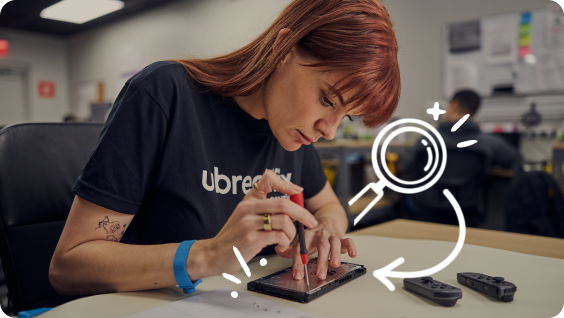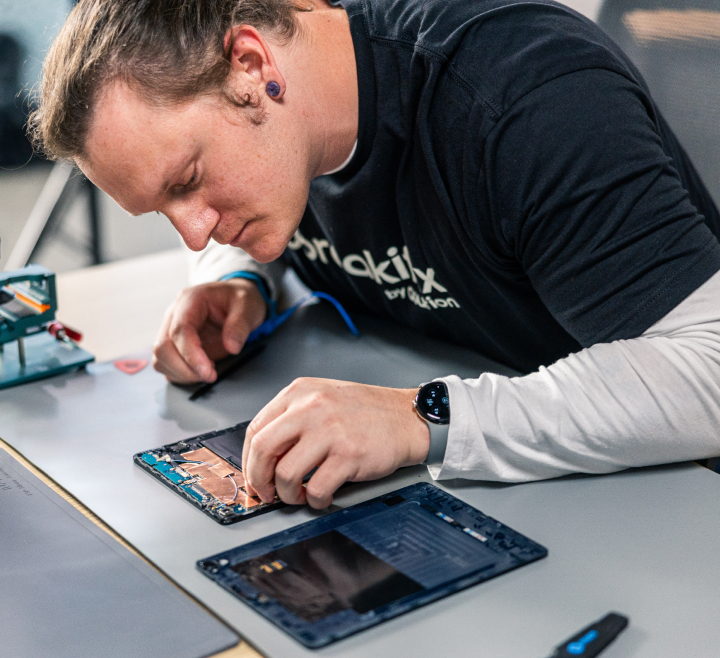
Trusted to fix any iPad
As an Independent Repair Provider for Apple®, our trusted experts are trained to get your broken device back up and running fast. And we’ll use Apple parts, tools, and equipment.
Our iPad microphone repairs are simple

2. Get quality repairs
We’ll run a free diagnostic on your iPad and provide fast, convenient repairs.

3. Sit back and relax
We’ll contact you when the repair is done so you can enjoy your iPad.

Quality repairs, right in your neighborhood
Trusted professionals. 700+ locations and thousands of experts.
Speedy service. Most repairs done as soon as same day.
Free diagnostics. Not sure what’s wrong? Let us take a look.
Low prices. We’ll beat any local competitor’s price.
1-year limited warranty. It comes standard with most of our repairs.
Your iPad is in good hands
Don’t leave important repairs to just anyone. For over 25 years, Asurion has repaired the devices people rely on most. And we have the reviews to prove it.
iPad microphone repairs from uBreakiFix by Asurion
At uBreakiFix® by Asurion stores, our objective is to offer unmatched service that's both quick and convenient. If you think you need a microphone repair for your iPad, let us help, and we'll get your tech back as quickly as possible. And to keep your device protected after you leave the store, we provide a 1-year limited warranty to back our work. We also give you a free diagnosis of your issue and estimate to ensure there are no surprises before service begins. Still looking for a “iPad microphone repair near you?" Since we have 700+ uBreakiFix by Asurion stores nationwide, you won't have to go far for your iPad microphone repair. Whether you're out and about or in your local area, feel free to drop in or schedule an appointment today—our experts will get right to work.
What price is a iPad microphone repair?
We extend a low price guarantee and superior standards for all our device services. As a registered Independent Repair Provider for Apple® and as one of the only tech repair companies with authorized service provider status from Samsung® and Google®, our experts can use authentic, approved parts made to the exact specifications of the original manufacturer—upholding the highest standards of repairs. Additionally, we'll even match any local competitor's regularly published price for the same repair—and beat it by $5. Our low price guarantee means you won't find a better deal for your iPad microphone repair.
How long do your iPad microphone repair services take?
While ensuring that your iPad microphone repair is completed correctly is paramount, we believe giving your tech back swiftly is just as crucial. Speed and convenience are the central pillars of our business model. For less complicated fixes, such as tablet screen replacements, our repair experts can have them done as soon as the same day. No matter the device issue, we'll keep you updated about your place in line so you're never out of the loop about your device.
Can you fix a microphone on a iPad?
Need help with a iPad microphone repair? Don't know what to do? Stop by your local uBreakiFix by Asurion location for in-store help and a free diagnostic from an expert. At uBreakiFix by Asurion, we're well aware of how panic-inducing it is to deal with faulty tech in need of a microphone repair. And our team has the resources and ability to get you—and your tech—back up to speed. We prioritize the needs of our customers by ensuring our repair professionals are ready for all sorts of issues, providing a rigorous training program for each of our in-store experts. In addition to the 1-year limited warranty provided alongside every repair, our OEM partnerships allow us to keep prices reasonable—without sacrificing the quality of our work. Ready to get started? Visit your local uBreakiFix by Asurion store today to keep your tech going strong.
We make iPad microphone repairs easy

Stop by your local store, and one of our experts will fix your iPad with or without an appointment. Can’t come in? We have mobile repair vans that’ll come to you in select cities.

The team at your local store can repair your iPad and resolve your tech problems too. Not sure what’s wrong with your device? We’ll diagnose it for free.

When customers visit our store, they receive fast, affordable tech repairs—many completed as soon as the same day. And most of those repairs come with a 1-year limited warranty.
What else can we fix for you?
The Asurion® trademarks and logos and the uBreakiFix® trademarks and logos are the property of Asurion, LLC and uBreakiFix Co. respectively. All rights reserved. All other trademarks are the property of their respective owners. Asurion and uBreakiFix are not affiliated with, sponsored by, or endorsed by any of the respective owners of the other trademarks appearing herein.
Apple, iPhone and iPad are trademarks of Apple, Inc. All other trademarks are the property of their respective owners. Asurion is not affiliated with, sponsored by, or endorsed by Apple or any of the respective owners of the other trademarks appearing herein.























